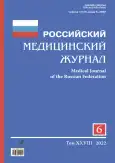Follicular occlusion syndrome in the practice of a coloproctologist
- Authors: Shlyk D.D.1, Ilyukhina Y.A.2, Pirogova A.S.1, Kitsenko Y.E.1, Tulina I.A.1, Teplyuk N.P.1, Tsarkov P.V.1
-
Affiliations:
- Sechenov First Moscow State Medical University (Sechenov University)
- Medical center «On clinic»
- Issue: Vol 28, No 6 (2022)
- Pages: 465-473
- Section: Case reports
- URL: https://journals.rcsi.science/0869-2106/article/view/232885
- DOI: https://doi.org/10.17816/medjrf114803
- ID: 232885
Cite item
Abstract
BACKGROUND: Pilonidal disease is the 4th most common disease among inpatient coloproctological patients and surgery remains the “gold standard” of its treatment. However, patients with pilonidal disease often have combined conditions with other follicular occlusion diseases which are most often encountered by dermatologists in their practice. In most cases it is difficult to treat follicular occlusion syndrome with pilonidal disease within one specialty. We demonstrate the complexity of follicular occlusion diseases diagnostics in combination with pilonidal disease, systemize the diagnostic protocol for patient management and present the treatment strategy for coloproctologists.
CLINICAL CASE DESCRIPTION: There was one case of patient with pilonidal disease combined with other conditions of follicular occlusion syndrome noted in the clinic of coloproctology and minimally invasive surgery. Surgery was the first step. There were no complications in the early postoperative period. After hospital discharge, the patient was consulted by a dermatologist, and local and systemic conservative therapy was prescribed for concomitant diseases, which resulted in a significant improvement. There have been no recent reports of recurrence.
CONCLUSION: The treatment of follicular occlusion syndrome with pilonidal disease requires a multidisciplinary approach. At the same time the optimal treatment for pilonidal disease is radical excision of all altered tissues. In cases of such diseases as hidradenitis suppurativa, acne conglobata, dissecting cellulitis of the scalp treatment should be comprehensive and begin with a dermatologist consultation.
Keywords
Full Text
##article.viewOnOriginalSite##About the authors
Darya D. Shlyk
Sechenov First Moscow State Medical University (Sechenov University)
Email: shlikdarya@gmail.com
ORCID iD: 0000-0002-9232-6520
SPIN-code: 4948-3550
MD, Cand. Sci. (Med.), assistant professor
Russian Federation, MoscowYulia A. Ilyukhina
Medical center «On clinic»
Email: iluhinaulia@gmail.com
ORCID iD: 0000-0002-3963-6407
coloproctologist
Russian Federation, MoscowAnna S. Pirogova
Sechenov First Moscow State Medical University (Sechenov University)
Email: annese@mail.ru
ORCID iD: 0000-0002-2246-1321
SPIN-code: 1419-2147
graduate student
Russian Federation, MoscowYury E. Kitsenko
Sechenov First Moscow State Medical University (Sechenov University)
Author for correspondence.
Email: kitsenko@kkmx.ru
ORCID iD: 0000-0002-4415-6141
SPIN-code: 4673-1926
MD, Cand. Sci. (Med.), assistant professor
Russian Federation, 2/4 B, Pirogovskaja street, 119991, MoscowInna A. Tulina
Sechenov First Moscow State Medical University (Sechenov University)
Email: tulina@kkmx.ru
ORCID iD: 0000-0002-6404-389X
SPIN-code: 7746-1226
MD, Cand. Sci. (Med.), assistant professor
Russian Federation, MoscowNatalya P. Teplyuk
Sechenov First Moscow State Medical University (Sechenov University)
Email: teplyukn@gmail.com
ORCID iD: 0000-0002-5800-4800
SPIN-code: 8013-3256
MD, Dr. Sci. (Med.), professor
Russian Federation, MoscowPetr V. Tsarkov
Sechenov First Moscow State Medical University (Sechenov University)
Email: tsarkov@kkmx.ru
ORCID iD: 0000-0002-7134-6821
SPIN-code: 7570-0664
MD, Dr. Sci. (Med.), professor
Russian Federation, MoscowReferences
- Shelygin JuA, Blagodarnyj LA, editors. Spravochnik po koloproktologii. Moscow: Litterra; 2012. (In Russ).
- Al-Khamis A, McCallum I, King PM, Bruce J: Healing by primary versus secondary intention after surgical treatment for pilonidal sinus. Cochrane Database Syst Rev. 2010;2010(1):CD006213. doi: 10.1002/14651858.CD006213.pub3
- Chintapatla S, Safarani N, Kumar S, Haboubi N. Sacrococcygeal pilonidal sinus: historical review, pathological insight and surgical options. Tech Coloproctol. 2003;7(1):3–8. doi: 10.1007/s101510300001
- Akinci OF, Kurt M, Terzi A, et al. Natal cleft deeper in patients with pilonidal sinus: implications for choice of surgical procedure. Dis Colon Rectum. 2009;52(5):1000–1002. doi: 10.1007/DCR.0b013e31819f6189
- Gasparic J, Theut Riis P, Jemec GB. Recognizing syndromic hidradenitis suppurativa: a review of the literature. J Eur Acad Dermatol Venereol. 2017;31(11):1809–1816. doi: 10.1111/jdv.14464
- Garg A, Kirby JS, Lavian J, et al. Sex- and age-adjusted population analysis of prevalence estimates for hidradenitis suppurativa in the United States. JAMA Dermatol. 2017;153(8):760–764. doi: 10.1001/jamadermatol.2017.0201
- Petersen S, Koch R, Stelzner S, et al. Primary closure techniques in chronic pilonidal sinus: a survey of the results of different surgical approaches. Dis Colon Rectum. 2002;45(11):1458–1467. doi: 10.1007/s10350-004-6451-2
- Fox S. The origin of pilonidal sinus. Surgery, Gynecology and Obstetrics. 1935;60:137–140.
- Dul’cev JuV, Rivkin VL. Jepitelial’nyj kopchikovyj hod. Moscow: Medicina; 1988. 129 p. (In Russ).
- Rivkin VL. Pilonidal cyst, rudimentary rest of the tail, the reason of sacrococcygeal purulence. Science and World. 2015;(9-1):127. (In Russ).
- Oganesjan S3. Jepitelial’nye hody i kisty kopchikovoj oblasti. Erevan: Ajastan; 1970. 183 p. (In Russ).
- Plewig G, Kligman AM. Acne: morphogenesis and treatment. Berlin: Springer-Verlag; 1975. 332 p.
- Bascom J. Pilonidal disease: origin from follicles of hairs and results of follicle removal as treatment. Surgery. 1980;87(5):567–572.
- Luz Ramos M, Muñoz-Pérez MA, Pons A, et al. Acne keloidalisnuchae and tufted hair folliculitis. Dermatology. 1997;194(1):71–73. doi: 10.1159/000246063
- Padilha-Gonçalves A. Infl ammatory tineacapitis (kerion) mimicking dissecting cellulitis. Int J Dermatol. 1992;31(1):66. doi: 10.1111/j.1365-4362.1992.tb03526.x
- Sperling LC. Infl ammatory tineacapitis (kerion) mimicking dissecting cellulitis. Occurrence in two adolescents. Int J Dermatol. 1991;30(3):190–192. doi: 10.1111/j.1365-4362.1991.tb03849.x
- Scheinfeld N. An atlas of the morphological manifestations of hidradenitis suppurativa. Dermatol Online J. 2014;20(4):22373.
- Hendricks AJ, Hsiao JL, Lowes MA, Shi VY. A comparison of international management guidelines for hidradenitis suppurativa. Dermatology. 2021;237(1):81–96. doi: 10.1159/000503605
- Vasanth V, Chandrashekar BS. Follicular occlusion tetrad. Indian Dermatol Online J. 2014;5(4):491–493. doi: 10.4103/2229-5178.142517
- Musumeci ML, Fiorentini F, Bianchi L, et al. Follicular occlusion tetrad in a male patient with pachyonychia congenita: clinical and genetic analysis. J Eur Acad Dermatol Venereol. 2019;(33 suppl. 6):36–39. doi: 10.1111/jdv.15851
Supplementary files









